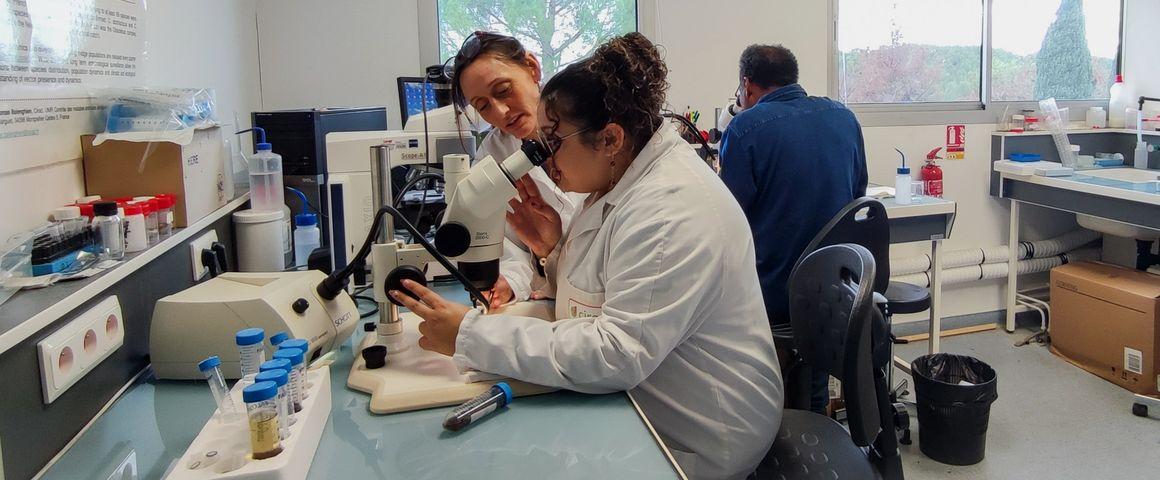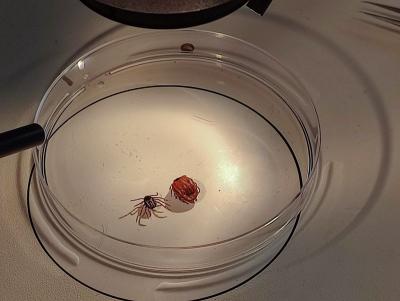Results & impact 10 October 2025
- Home
- Press area
- Press releases
- Crimean-Congo haemorrhagic fever tick Hyalomma marginatum
First detection of Crimean-Congo haemorrhagic fever virus in the South of France

A CIRAD team specialized in ticks (Laurence Vial and Célia Bernard) has detected the CCHF virus in ticks of the species Hyalomma marginatum for the first time in France. © M. Gatius, Cirad.
Since 2015, in the context of a convention with the French General Directorate for Food (DGAL), CIRAD has been studying and monitoring the tick Hyalomma marginatum, one of the known vectors of Crimean-Congo haemorrhagic fever virus (CCHF). Studies focus in particular on its range, the pattern of its invasion in France, its seasonal dynamics, its hosts and the infectious agents it carries. The goal is to assess the risks associated with this vector and with the diseases it can transmit. Every year in spring, ticks are collected in equestrian structures and cattle farms. This year for the first time, around 100 ticks of a total 2 000 collected in spring 2022 and especially 2023 tested positive for the presence of CCHF virus. These results were confirmed in October by the Institut Pasteur’s national reference centre for viral haemorrhagic fevers (VHFs).
Hyalomma marginatum is a relatively large hard-bodied tick (8 mm), recognisable for its long rostrum and bicolour legs (pale stripes on the joints). It is found in garrigue scrubland or some grasslands along the Mediterranean coast, from the Spanish border to the Var department in France, and up to the Ardèche and Drôme departments. Adults of the species bite domestic and wild ungulates (cattle, horses, wild boar and, to a lesser extent, small ruminants or cervids), without danger to these animals, since even when infected by CCHF virus, they do not develop symptoms. Adult ticks may also occasionally bite humans. They are only active in spring, between April and July.
“Our collections have shown that the tick is found all along the Mediterranean coast, in open, relatively dry natural habitats such as garrigue or maquis scrubland. According to future climate models, the Mediterranean climate is likely to expand, in particular into the Rhone Valley and along the west Atlantic coast. It is therefore likely that the range of this species will also expand”, says Laurence Vial, an acarological veterinarian at CIRAD and an expert on ticks.
Caution is required in garrigue, maquis and grassland between April and July
The frequency of human tick bites is assumed to be low, since these ticks are not particularly attracted to humans. Moreover, they are generally more visible than other species of ticks, being somewhat larger and therefore easier to spot and remove before they attach and feed.
CCHF virus can also be transmitted to humans through contact with infected animals’ bodily fluids, such as blood, bearing in mind that these animals only remain viraemic for around 10 days before developing an immune response (with lifelong persistence of antibodies).
“In Spain, CCHF virus was detected in ticks of the genus Hyalomma several years before the appearance of human cases. Currently, one to three human cases of haemorrhagic fever are reported every year in Spain, but it is another species of tick that is considered to be the main vector there: Hyalomma lusitanicum. In France, the range of this species is still unknown and needs to be studied. We may be looking at a different epidemiological cycle, hence the need for caution when comparing the situations in Spain and France”, says Laurence Vial.
These results were made possible by CIRAD's collaboration with Innovative Diagnostics, a company based in Montpellier. Founded in 2004, this small to medium-sized enterprise (SME) with 180 employees develops, produces and markets serological (ELISA) and molecular biology (PCR) diagnostic tests. These tools are used worldwide by public and private laboratories for the detection and control of animal diseases (IDvet range), some of which may be transmissible to humans, contributing to the prevention of emerging diseases.
Innovative Diagnostics, which already has a serological kit for the detection of CCHF whose performance is internationally recognized, has contributed to this work by optimizing and standardizing protocols for the detection of the CCHF virus. The success of this collaboration illustrates the benefits of exchanges and partnerships between the academic and business sectors, within a local network of excellence. The innovative tools obtained have enabled the detection of emergencies, meeting the needs of healthcare authorities. This research is part of the "One Health" global health concept, which considers human, animal, plant and environmental health to be intimately linked.
References
Bernard Célia, Holzmuller Philippe, Bah Madiou Thierno, Bastien Matthieu, Combes Benoit, Jori Ferran, Grosbois Vladimir, Vial Laurence. 2022. Systematic review on Crimean–Congo hemorrhagic fever enzootic cycle and factors favoring virus transmission: Special focus on France, an apparently free-disease area in Europe. Frontiers in Veterinary Science, 9:932304, 17 p.
Bah Thierno Madiou, Grosbois Vladimir, Stachurski Frédéric, Munoz Facundo, Duhayon Maxime, Rakotoarivony Ignace, Appelgren Anaïs, Calloix Clément, Noguera Liz, Mouillaud Théo, Andary Charlotte, Lancelot Renaud, Huber Karine, Garros Claire, Leblond Agnès, Vial Laurence. 2022. The Crimean-Congo haemorrhagic fever tick vector Hyalomma marginatum in south of France: Modelling its distribution and determination of factors influencing its establishment in a newly invaded area. Transboundary and Emerging Diseases, 69 (5) : e2351-e2365.
Vial L, Stachurski F, Leblond A, Huber K, Vourc'h G, René-Martellet M, Desjardins I, Balança G, Grosbois V, Pradier S, Gély M, Appelgren A, Estrada-Peña A. Strong evidence for the presence of the tick Hyalomma marginatum Koch, 1844 in southern continental France. Ticks Tick Borne Dis. 2016 Oct;7(6):1162-1167. doi: 10.1016/j.ttbdis.2016.08.002




























